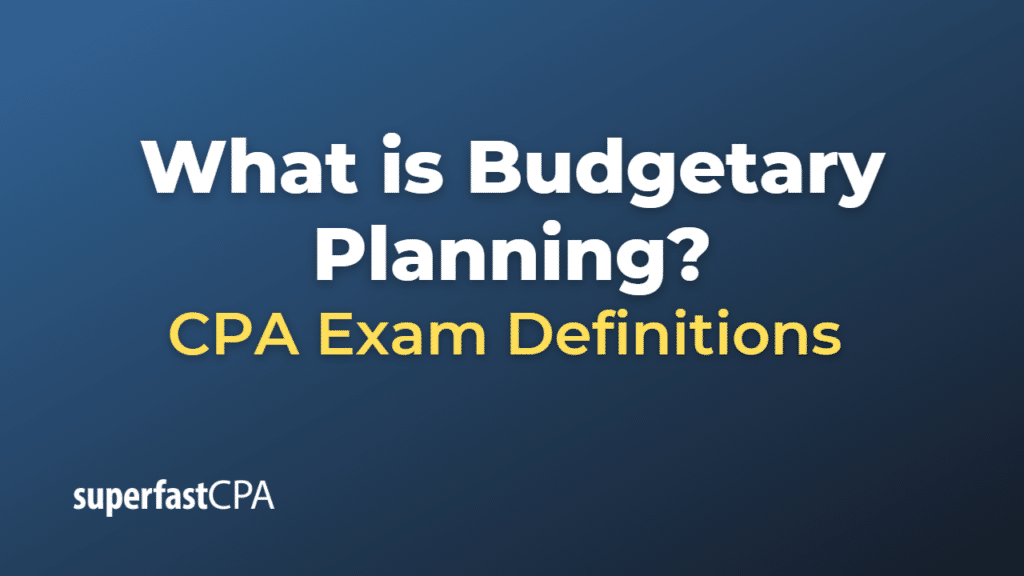Budgetary Planning
Budgetary planning is the process of preparing a detailed financial plan, known as a budget, for a specific period (usually a fiscal year). It involves forecasting revenues, expenses, and financial performance for the upcoming period based on historical data, market trends, and the organization’s strategic objectives. The primary purpose of budgetary planning is to allocate resources effectively, provide financial guidance, set performance targets, and support decision-making within the organization.
Budgetary planning typically involves the following steps:
- Establish objectives: Determine the organization’s strategic goals and financial targets for the upcoming period, such as revenue growth, cost reduction, or profitability improvement.
- Gather data: Collect historical financial data, industry benchmarks, and market trends to support the budgeting process. This information helps in making informed assumptions and projections for the upcoming period.
- Forecast revenues: Estimate expected revenues based on factors such as sales volume, pricing, and market conditions. This involves assessing the organization’s market position, potential demand, and revenue-generating opportunities.
- Estimate expenses: Identify and project all costs associated with running the organization, including fixed costs (e.g., rent, salaries) and variable costs (e.g., materials, utilities). This step may also involve evaluating cost-saving opportunities and efficiency improvements.
- Prepare the budget: Develop a comprehensive financial plan that outlines expected revenues, expenses, and financial targets for the upcoming period. The budget should be detailed and well-structured, with clear allocation of resources to various departments, teams, or projects.
- Obtain approval: Present the budget to the organization’s management or board of directors for review and approval. This step may involve discussions, revisions, and negotiations to ensure that the budget aligns with the organization’s strategic objectives.
- Communicate and implement the budget: Once approved, communicate the budget to all relevant stakeholders, ensuring that they understand their responsibilities and performance targets. Implement the budget and integrate it into the organization’s financial management systems and processes.
- Monitor and adjust the budget: Regularly review and compare actual financial performance against the budget, identifying variances and taking corrective actions if necessary.
Budgetary planning is a crucial component of effective financial management, as it helps organizations allocate resources efficiently, maintain financial stability, and achieve their strategic objectives. By engaging in comprehensive budgetary planning, organizations can foster responsible financial behavior, improve decision-making, and enhance their overall performance.
Example of Budgetary Planning
Let’s consider an example of budgetary planning for a small retail business.
Suppose the owner of a boutique clothing store wants to create a budget for the upcoming fiscal year. The store has been in operation for three years, and the owner has historical financial data to work with. Here’s how the budgetary planning process might unfold:
- Establish objectives: The owner sets the following objectives for the upcoming fiscal year: increase sales by 15%, maintain gross margin at 50%, and reduce operating expenses by 5%.
- Gather data: The owner reviews the previous years’ financial statements, recent market trends, and industry benchmarks to inform the budgeting process.
- Forecast revenues: Based on historical sales data and the 15% sales growth target, the owner projects the following revenues for the upcoming fiscal year:
- Q1: $100,000
- Q2: $125,000
- Q3: $150,000
- Q4: $175,000
- Total: $550,000
- Estimate expenses: The owner forecasts the cost of goods sold (COGS) and operating expenses for the upcoming fiscal year, factoring in the target of maintaining a 50% gross margin and reducing operating expenses by 5%. This results in the following projections:
- COGS: $275,000 (50% of revenues)
- Operating expenses: $180,000 (5% reduction from the previous year)
- Prepare the budget: The owner creates a detailed budget for the upcoming fiscal year, including expected revenues, COGS, operating expenses, and net income projections. The budget also allocates resources to various departments, such as marketing, inventory purchasing, and payroll.
- Obtain approval: As the owner of the business, they review and approve the budget, ensuring it aligns with the strategic objectives they set at the beginning of the process.
- Communicate and implement the budget: The owner shares the budget with the store manager and other relevant team members, making sure they understand their responsibilities and targets. The budget is then integrated into the store’s financial management systems and processes.
- Monitor and adjust the budget: Throughout the fiscal year, the owner and store manager regularly review actual financial performance against the budget, identifying any variances and making adjustments as needed.
In this example, the boutique clothing store owner uses budgetary planning to set financial targets, allocate resources, and guide decision-making for the upcoming fiscal year. By closely monitoring and adjusting the budget throughout the year, the store can respond to changes in market conditions and make informed decisions that support its long-term success.













